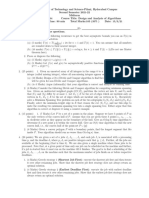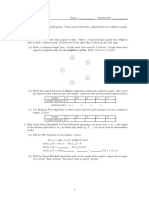Data Structures and Algorithms
Uploaded by
mohammed qasimData Structures and Algorithms
Uploaded by
mohammed qasimr
i to
CMPSC 465 Data Structures & Algorithms
Spring 2022 Chunhao Wang and Mingfu Shao Midterm Part 2
Ed
1. (8 + 6 + 6 = 20 pts.) Consider the directed graph G given below.
1. Run DFS-with-timing on this graph G: give the pre and post number of each vertex. Whenever there
is a choice of vertices to explore, always pick the one that is alphabetically first.
2. Draw the meta-graph of G.
DF
3. What is the minimum number of edges you must add to G to make it strongly connected (i.e., it consists
of a single connected component after adding these edges)? Give such a set of edges.
rP
te
as
M
2. (20 pts.) You are given a directed graph G = (V, E). Design an algorithm to determine if there exist two
in
distinct vertices u, v ∈ V such that for every vertex w ∈ V \ {u, v} either w can reach u, or w can reach
v, or both. Describe your algorithm, analyze its running time, and explain why it is correct. Your algorithm
should run in O(|V | + |E|) time. (Hint: You may find Problem 3 in Assignment 06 relevant.)
3. (7 + 7 = 14 pts.)
ed
1. Design an instance of convex hull problem with 7 points, such that if Graham-Scan algorithm runs on
your instance, the sequence of stack operations is (push, push, push, push, push, pop, pop, pop, push,
push). Include a visual illustration of these 7 points and the convex hull. You will need to guarantee
no three points in your instance locate on the same line.
at
2. Give 7 lines such that the convex hull of their dual points has 3 vertices. Include a visual illustration
of your 7 lines and their dual points, and label which line corresponds to which dual point. You will
need to guarantee no two lines are parallel and no three lines intersect at the same point.
re
CMPSC 465, Spring 2022, Midterm Part 2 1
r
4. (8 + 15.5 = 23.5 pts.) You are given a directed graph G = (V, E), a vertex s ∈ V , edge length c(e) for
i to
each e ∈ E, and an integer d > 0; c(e) could be negative but the graph does not contain negative cycles.
We aim to find the length of the shortest path from s to each vertex such that the number of edges on it is at
most d. In other words, we do not consider paths with more than d edges; among the paths from s to each
vertex with at most d edges, we aim to find the shortest one.
Ed
1. A simple intuition is to use Bellman-Ford algorithm but run d instead of |V | − 1 rounds. Give an
example where this algorithm does not work.
2. Design an algorithm that does work, analyze its running time, and explain why it is correct. Your
algorithm should run in O(|V | · |E|) time. (Hint: modify Bellman-Ford algorithm by adding a data
structure companied with dist array to keep track of the number of edges.)
DF
rP
te
as
M
in
ed
at
re
CMPSC 465, Spring 2022, Midterm Part 2 2
You might also like
- Suppose Widgets Are Made Using Staplers (K) and Labor (L) - The Production Function For A Widget Manufacturer Is Given byNo ratings yetSuppose Widgets Are Made Using Staplers (K) and Labor (L) - The Production Function For A Widget Manufacturer Is Given by6 pages
- STAD70 Statistics & Finance II: Assignment 2No ratings yetSTAD70 Statistics & Finance II: Assignment 23 pages
- GPU Programming EE 4702-1 Take-Home Pre-Final Examination: Name SolutionNo ratings yetGPU Programming EE 4702-1 Take-Home Pre-Final Examination: Name Solution12 pages
- GPU Programming EE 4702-1 Final Examination: Exam TotalNo ratings yetGPU Programming EE 4702-1 Final Examination: Exam Total10 pages
- CSE 373 Sample Final Exam: Instructions Read The Directions For Each Question Carefully Before Answering. We MayNo ratings yetCSE 373 Sample Final Exam: Instructions Read The Directions For Each Question Carefully Before Answering. We May12 pages
- 4WM20 - Exercises Lecture 2: 1 Creating Your Own Bode PlotNo ratings yet4WM20 - Exercises Lecture 2: 1 Creating Your Own Bode Plot3 pages
- Kuwait University Dept. of Chemical Engineering Spring 2017/2018No ratings yetKuwait University Dept. of Chemical Engineering Spring 2017/20188 pages
- Line Drawing Algorithm: Mastering Techniques for Precision Image RenderingFrom EverandLine Drawing Algorithm: Mastering Techniques for Precision Image RenderingNo ratings yet
- Application of Bernoulli's Equation of Flow Measurement - Oxford Brookes UniversityNo ratings yetApplication of Bernoulli's Equation of Flow Measurement - Oxford Brookes University31 pages
- International Institute of Management & Technical Studies: Structural Analysis - IINo ratings yetInternational Institute of Management & Technical Studies: Structural Analysis - II5 pages
- Applications of SHORTEST PATH ALGORITHMSNo ratings yetApplications of SHORTEST PATH ALGORITHMS31 pages
- Graph Algorithms: Text Book: Introduction To Algorithms ByclrsNo ratings yetGraph Algorithms: Text Book: Introduction To Algorithms Byclrs142 pages
- CS502 - Fundamentals of Algorithms Student ID: MC120402396 Assignment 4 AnswerNo ratings yetCS502 - Fundamentals of Algorithms Student ID: MC120402396 Assignment 4 Answer2 pages
- Fundamental Problems AND Algorithms Graph Theory and CombinationalNo ratings yetFundamental Problems AND Algorithms Graph Theory and Combinational31 pages
- Design and Analysis of Algorithms CO 401: Ash Mohammad AbbasNo ratings yetDesign and Analysis of Algorithms CO 401: Ash Mohammad Abbas18 pages
- Lecture Notes On Advanced Data StructuresNo ratings yetLecture Notes On Advanced Data Structures19 pages
- Data Structure and Algorithm: Buddhi Raj GurungNo ratings yetData Structure and Algorithm: Buddhi Raj Gurung40 pages
- Data Structures and Algorithms Problems Techie Delight PDFNo ratings yetData Structures and Algorithms Problems Techie Delight PDF21 pages
































































































